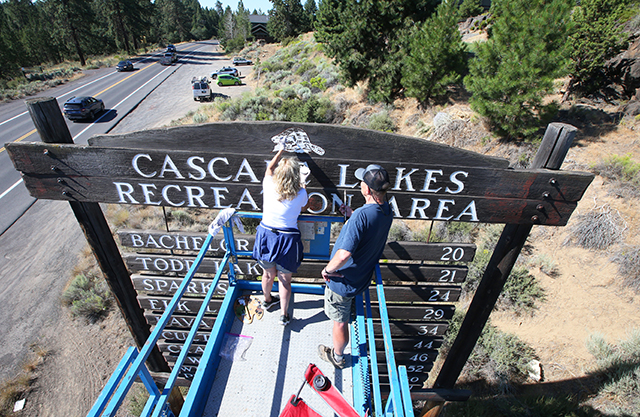Windmills help Central Oregon golf
Published 4:00 am Wednesday, January 18, 2012
PRINEVILLE — Getting a whiff of a smell similar to rotten eggs is unwelcome on a golf course, or just about anywhere else.
But for years at Meadow Lakes Golf Course — Prineville’s 19-year-old municipal golf course that doubles as the city’s wastewater disposal facility — that odor would emanate from some of its 10 ponds.
Trending
“It was just a horrible smell,” says Eric Klann, Prineville’s city engineer.
That sent the city of Prineville to Google in 2010, searching for solutions. And what the city found was a modern use of an old technology and a decidedly green solution: windmills.
The windmills — 24 feet high and created by Canada-based Koenders Windmills — are used to aerate the pond, in a process similar to the bubble-creating pumps commonly used in fish tanks.
The wastewater stored in the ponds was hardly the main issue, Klann says. In fact, what was turning up at Meadow Lakes were problems not unusual at many of the lakes and ponds on Central Oregon golf courses: stagnant water and rotting organic material.
Most courses deal with those problems by using water features such as fountains. But Meadow Lakes had no power running to its ponds — an expensive proposition to add — and no real ability to operate fountains. And after nearly two decades in operation, Meadow Lakes came to realize that its stinky situation was only getting worse.
“There’s been just a HUGE accumulation of organic material at the bottom of the ponds,” says Klann, explaining that the material includes such things as leaves and wayward divots.
Trending
“By not aerating, natural-occurring bacteria just can’t break down that material,” Klann explains. “So that organic burden on the bottom of the pond just keeps increasing and increasing. And at the end of the day, there’s so much organic material at the bottom of the pond that your water quality really starts to diminish.”
At a cost of about $3,000 each, Meadow Lakes installed the first windmill in April 2010 on the edge of the pond on hole No. 1. Now the course has three windmills installed, with two more set for this spring. It appears that Meadow Lakes has found the solution it was looking for.
What does wind have to do with water?
Obviously, wind propels each windmill, which powers a small pump at the top of the structure. That pump forces oxygen down tubes into diffusers (two or three from each windmill, depending on the size of the pond), which are placed on the bottom of each pond. At the point where it enters the pond, the air then travels through a porous stone that turns large air bubbles into thousands of tiny air bubbles, creating more surface area to diffuse oxygen.
The windmills’ only real regular maintenance is during winter to load a tank attached to each windmill with alcohol to keep the lines from freezing. And because the windmills run on wind alone, there are no power costs, says Steve Reynolds, course superintendent at Meadow Lakes.
“For the most part we think it’s been successful,” Klann says.
This use of windmills is relatively common on farms, some of which use them to aerate irrigation water, according to Koenders’ website. But golf courses beyond Meadow Lakes are taking notice, too.
Crooked River Ranch installed its first windmill last summer, hoping to prevent the algae blooms (also a problem at Meadow Lakes) in the pond on the eighth hole, says Richard Jensen, CRR superintendent.
Jensen sought advice from Reynolds and online on superintendent forums to fix the problem.
“It’s a shallow pond on one side of it, and once the water stratifies and warms throughout we get really good algae blooms out of there,” says Jensen, whose windmill was produced by Outdoor Water Solutions in Springdale, Ark. “There are some pretty good testimonials across the country. I know a lot of fish-production farms down South are using them, especially to keep the ice clear in the winter.”
Crooked River Ranch’s pond, which contains the irrigation water used on the course’s front nine, does feature a fountain. But Jensen suspects the windmill will be more successful in keeping algae at bay.
“This is a more effective way of getting oxygen in the water, starting at the bottom and working up,” says Jensen, who adds that he plans to add two more windmills on the course’s back-nine ponds.
Meadow Lakes’ rotten-egg smell — which Klann says is a particular problem when frozen ponds thaw and release gas that had been trapped under ice, and in summer when algae blooms feed off the warm water — has largely gone away on the treated ponds.
But the odor did return recently on the course’s windmill-aided pond on the 10th hole. Reynolds says an air line from the windmill clogged, preventing the system from working properly.
“It was a horrible, horrible smell, which is bad that we had the problem, but it’s kind of good to know that when the windmill stopped working the problem came back,” says Klann, who views the experience with the clogged line as affirmation that the windmills are effective.
For the most part, the windmills are out of the line of fire of golfers.
In fact, any grumbling about the green-and-yellow windmills Alan Hoover has heard since becoming Meadow Lakes’ head pro last summer has been limited to a specific group.
“The only ones that mention the windmills are the (Oregon State University) Beaver fans,” Hoover says with a laugh. (Koenders Windmills’ basic color scheme is green and yellow, which happen to be the colors of OSU’s archrivals, the University of Oregon Ducks.)
The windmill-aided ponds at Meadow Lakes and Crooked River Ranch are still murky, but Klann, Reynolds and Jensen say that condition should slowly improve, too.
Most important for Meadow Lakes, the windmills created a relatively low-cost solution to a stinky problem.
To trench power to each pond for fountains would have been prohibitively expensive, Klann says. Chemical treatment options are messy, and costly too.
As long the wind continues to blow, Meadow Lakes thinks it has its answer.
“We’re trying to make it better at the least cost possible,” says Klann. “It’s a beautiful course, it really is. And we’re just trying to keep it beautiful.”







